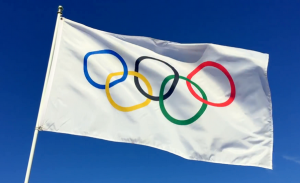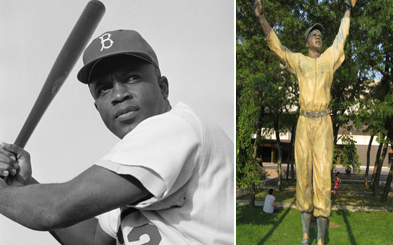Symbolic Meanings of the Olympic Rings and Flame
Since the Modern Olympic Games was rebooted in 1896, the event has dazzled the world with some of the finest and greatest athletes in history. In addition to this, the International Olympic Committee (IOC) (the body that runs Olympic Games) has never shied away from garnishing this global spectacle with amazing arts and choreographed performances both at the opening and closing ceremonies. Amidst all of this, you probably have taken notice of the Olympic flag. What about the Olympic flame and torch? What do all those symbols and brief rituals of the Modern Olympic Games mean? Let’s find out below:
Meaning of the Olympic Flag

The Olympic flag with its five rings.
That famous Olympic flag you see every four years at the summer Olympics or the winter Olympics is the handwork of Pierre de Coubertin. The IOC president at that time, Coubertin, submitted the 5 interlaced ringed flags to the committee in 1914. They symbolically represent the five parts (continents) of the world. The five colors, from left to right, are blue, yellow, black, green, and red.
The distinct color of each ring represents the richness and diversity of people all over the world. It is an amazing symbol that drums the IOC’s pursuit of diversity and togetherness using sports.
The Games, right from its onset, began reaching out to countries from all four corners of the world. They were open to participants regardless of their race, religion, ethnicity and sexual orientation. One could also interpret those colors on the flag, and how interconnected the rings are, as showcasing the value of teamwork in sports as well as all other human endeavors.
The Significance of the Olympic Relay Torch and Flame
Carl Diem, an organizer at the 1936 Berlin Olympics, introduced the torch relay idea. However, the flame part came a bit earlier. It was first introduced in Amsterdam in 1928. The flame is symbolic for peace and togetherness. The act has its roots deep in Ancient Greek traditions. Those traditions involved sacrifices to Zeus (King of all Greek gods) at at temples and shrines. Often times, there was a large fire in a basin that always burned at those temples of Zeus.

The Olympic torch was introduced in 1936.
Today, the IOC does not perform any of those to honor anyone or any god. Rather, the significance or essence of this act is to instill the idea of continuity and advancement. That is, the Olympic torch symbolizes our movement from the past to present. As a result, the Olympic Relay Torch always starts from Olympia, Greece, and makes its way across oceans to several countries before it eventually gets to the host city.
The IOC ensures that the Olympic Relay Torch makes a trip to all 7 continents before arriving at the host city. Once it arrives at the host city, it moves to the host venue and thereafter it is used to light the large basin of fire (the Olympic Cauldron) in the stadium.
As the Olympic Games grew, both in commercial and public appeal, the IOC resorted to using famous celebrities and former Olympic medalists to carry the Olympic torch.
Some celebrities that have carried the Olympic torch include Tom Cruise, John Legend, Aretha Franklin, Ellen DeGeneres, Sylverster Stallone, Arnold Schwarzenegger, Li Ning, and Amitabh Bachchan. Examples of those select few athletes that have actually lit the Olympic cauldron are Mohammad Ali (boxing), Li Ning (artistic gymnastics), Wayne Gretzky (Ice hockey), Desiree Henry (track and field), Cathy Freeman (track and field), Yoshinori Sakai (track and field), Sanda Dubravcic (figure skating), Fritz Schilgen (track and field).
Thus, a fire that was once at the birthplace of the Games (Greece) is sort of lent out to the host country. Many historians have drawn parallels of this act to the Greek god of fire, Prometheus.
Additionally, some accounts of the story in ancient Greek mythology regard the Titan Prometheus as the creator of human beings (mortals). He is believed to have once stolen fire from Zeus and gifted it to the human population. Had it not been for his thievery and trickery, men would not have been able to keep warm or even cook. The Greek Titan is also credited with scientific and artistic developments that nudged the Ancient Greeks into a civilized society.
FAQs about the Olympic Rings and Flame
These questions and their respective answers best summarize the significance and history behind the Olympic Rings and Flame.
Questions and answers about the Olympic Rings:
What do the Olympic Rings represent?
Well, the five rings simply represent the union of the five continents of the world (Africa, America, Asia, Europe, and Oceania) and the meeting of athletes from these continents in the Olympic Games.
Why are there five rings?
There are five rings to symbolize the five inhabited continents of the world.
What do the colors of the Olympic Rings mean?
The colors of the rings (blue, yellow, black, green, and red) were chosen because every nation had at least one of these colors in its national flag at the time the symbol was created.
Who designed the Olympic Rings?
The Olympic Rings were designed in 1913 by Pierre de Coubertin, the founder of the modern Olympic Movement.
Where were the Olympic Rings first displayed?
The rings made their debut at the 1920 Olympic Games in Antwerp, Belgium.
Questions and answers about the Olympic Flame:
What does the Olympic Flame symbolize?
The flame symbolizes the light of spirit, knowledge, and life. Its origins trace back to ancient Greece, where a flame was lit using the sun’s rays at Olympia during the ancient Olympic Games.
How is the Olympic Flame lit?
The flame is lit in a ceremony in Olympia, Greece, using a parabolic mirror to focus the sun’s rays. It is then relayed to the host city of the Olympic Games.
Has the Olympic Flame ever gone out?
Yes. There have been occasions where the flame has gone out due to various reasons, including weather conditions. However, there are always backup flames that were lit from the same original source in Olympia to ensure the continuity of the flame.
How long does the Olympic Torch Relay last?
The duration of the Olympic Torch Relay varies depending on the distance and the route planned by the host city. Typically, it can last from several days to several months.
Who carries the Olympic Torch?
Torchbearers are chosen for their achievements or their contributions to society. They can range from famous celebrities to everyday heroes.
Why is there an Olympic Flame and Torch Relay?
The relay represents a connection between the ancient and modern Games. It is a symbol of peace, unity, and friendship.



























